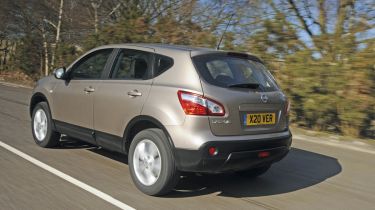Nissan Qashqai 1.5 dCi Acenta
If one car maker knows what it takes to triumph in this sector, it’s Nissan.
If one car maker knows what it takes to triumph in this sector, it’s Nissan. The Qashqai set the agenda in the crossover class when it replaced the dull Almera hatchback as the Japanese firm’s family offering. Mixing compact proportions with sleek styling and car-like dynamics, it’s just as revolutionary, in its own way, as the original Renault Espace or Range Rover.
In this company, the pretty Nissan is something of an old-timer, but a facelift has given the Qashqai a well timed shot in the arm. There wasn’t much wrong with the look of the original model, yet the revised car is even better than before.
Its new headlamps and ribbed bonnet in particular help to provide a much more distinctive and bold new nose.
Inside the updates are harder to spot, but the changes are still welcome. They include revised instrumentation, with a digital display for the trip computer, and improved refinement – the latter thanks to additional sound deadening and a new ‘acoustic’ windscreen.
What these changes can’t disguise is the Nissan’s lack of space.
Its 410-litre boot is the smallest on test, and it has a high loading lip. The basic folding rear seats don’t lay flat, either, and it’s the only car not to feature a 12-volt power socket in the boot. The Qashqai’s cabin is also cosy compared to its rivals, thanks to its small side windows, although our tape measure revealed the Japanese model provided the most rear legroom of all our contenders.
Used - available now

2020 Nissan
Qashqai
19,398 milesManualPetrol1.3L
Cash £12,700
2022 Nissan
Qashqai
15,477 milesManualPetrol1.3L
Cash £14,587
2018 Nissan
Qashqai
19,700 milesAutomaticDiesel1.5L
Cash £16,087
2020 Nissan
Qashqai
18,926 milesAutomaticPetrol1.3L
Cash £15,900The simple cabin is well finished, and Acenta trim comes equipped with cruise control and Bluetooth phone connectivity as standard. Plus, thanks to the latest round of updates, all Qashqais now get electronic stability control. However, at £18,495 the Nissan is the most expensive model in our line-up.
Despite its high asking price, the car features the smallest-capacity engine. The 1.5-litre dCi produces 105bhp and 240Nm of torque, putting it last in the power stakes. Predictably, it trails its rivals against the clock from a standing start, but only the much more powerful Hyundai had a significant advantage.
It’s not all bad news, though, as the Qashqai beat the Yeti in our in-gear tests. Unlike the Skoda, it features a six-speed box and its closer ratios allow you to make the most of the available power.
The reason for the Nissan’s sales success is even more apparent on the road, where the car feels much smaller and more agile than the Peugeot or Hyundai. Its well judged suspension provides an excellent balance between handling and ride, so the Qashqai’s poise in corners doesn’t come at the expense of comfort. It was also the most composed machine during our high-speed braking tests.
The Qashqai isn’t as refined as the 3008 or ix35, but what it lacks here it more than makes up for with entertaining dynamics, precise controls and a car-like feel from behind the wheel. It looks even more attractive when it’s time to fill up, because the Nissan’s smaller diesel engine pays dividends at the pumps. In our hands it posted a return of 38.1mpg – a figure only the Skoda could beat – and it has the lowest CO2 emissions of our quartet.
Despite its high list price, the evergreen Nissan is definitely one of the cars to beat. So, is it good enough to reclaim its crown?
Details
Chart position: 2WHY: The car that can be credited with starting the crossover craze is still a tough contender in the class. And this is the facelifted Qashqai’s road test debut.







